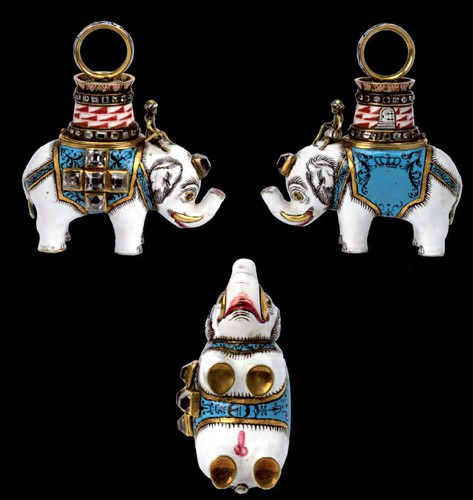On 18 May 1808, Napoleon I was named knight of the Order of the Elephant by King Frederik VI of Denmark. Announced shortly after the Treaty of Fontainebleau had been concluded (31 October 1807), this act sealed the alliance between France and Denmark. It was also the first nomination made by the new king upon his arrival on the throne, on 13 May 1808, and the first time that a French sovereign had been inducted into this prestigious Danish order. Niels Rosenkrantz (1757-1824), diplomat and Denmark’s future Minister of Foreign Affairs, was dispatched to France to deliver the order’s insignia to the emperor.
At 9am on 6 July, Napoleon received Rosenkrantz in a private audience in Bayonne, during which he accepted the insignia, a “testament to the king’s constant devotion and his dedication to their union against the common enemy”. On 12 July, the emperor wrote to offer his thanks to the Danish king: “Monsieur mon Frère, M. de Rosenkrantz, your Majesty’s chamberlain, presented me with the insignia of the Order of the Elephant […] I thank you for this mark of your friendship”. Details of the insignia are found in the 1811 inventory of the imperial wardrobe.
The Order of the Elephant is a chivalric order whose statutes were officially established in 1693 but whose origins date back to a confraternity founded in the fifteenth-century. The order numbers – not including members of the royal family – are limited to thirty knights, noblemen and officials of the Lutheran Church. The insignia is “a white enamelled elephant bearing, on blue and white housing with gold fringing, a sable – that is to say, black – watchtower”. Upon the death of a knight, the insignia and articles were returned to the order. Napoleon’s elephant is the exception to this rule. Seized along with the emperor’s personal effects and berline after the Battle of Waterloo, the insignia was presented by Blücher to the Prussian king. It was subsequently held in various German museums until 1946, when it was transferred to the State Historical Museum in Moscow. On 1984, it went on display in the Russian capital as part of commemorative events organised to mark the sixtieth anniversary of diplomatic relations between the Soviet Union and Denmark. Any suggestion that the insignia would be returned to Copenhagen as per the order’s statutes was abandoned.
Napoleon’s elephant appears to be a baroque style insignia based on an older model, probably dating back to the latter third of the eighteenth-century. It features male sex organs and a characteristic short trunk, and differs from other early nineteenth-century insignia produced by Nicolai Christiensen (1771-1832), the order’s manufacturer. The king’s monogram has been removed. Danish tradition required that – upon the death of a monarch – the royal monogram be removed from all insignia returned to the order. It is possible that the court jeweller did not have enough time to add the new sovereign’s monogram to the insignia before it was presented to Napoleon.
Anne de Chefdebien (tr. H.D.W.)
Curator, Musée de la Légion d’honneur
March 2012
This decoration features as part of the “La Berline de Napoléon. Le mystère du butin de Waterloo” exhibition, on display at the Musée de la Légion d’honneur et des ordres de chevalerie between 7 March and 8 July 2012.


